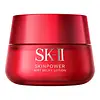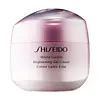What's inside
What's inside
 Key Ingredients
Key Ingredients

 Benefits
Benefits

 Concerns
Concerns

 Ingredients Side-by-side
Ingredients Side-by-side

Water
Skin ConditioningGalactomyces Ferment Filtrate
HumectantGlycerin
HumectantNiacinamide
SmoothingIsohexadecane
EmollientPentylene Glycol
Skin ConditioningXylitol
HumectantDimethicone
EmollientIsopropyl Isostearate
EmollientButylene Glycol
HumectantPolyacrylamide
Vinyl Dimethicone/Methicone Silsesquioxane Crosspolymer
Stearyl Alcohol
EmollientC13-14 Isoparaffin
EmollientCetyl Alcohol
EmollientPanthenol
Skin ConditioningTocopheryl Acetate
AntioxidantBehenyl Alcohol
EmollientBenzyl Alcohol
PerfumingDimethiconol
EmollientSodium Acrylate/Sodium Acryloyldimethyl Taurate Copolymer
Emulsion StabilisingLaureth-7
EmulsifyingMethylparaben
PreservativePEG-100 Stearate
Parfum
MaskingSorbitan Stearate
EmulsifyingDisodium EDTA
Paeonia Albiflora Root Extract
Skin ConditioningPropylparaben
PreservativeCetearyl Alcohol
EmollientCetearyl Glucoside
EmulsifyingEthylparaben
PreservativePalmitic Acid
EmollientStearic Acid
CleansingPolymethylsilsesquioxane
Polysorbate 80
EmulsifyingPEG-7 Glyceryl Cocoate
EmulsifyingSodium Hydroxide
BufferingSorbitan Oleate
EmulsifyingHouttuynia Cordata Extract
Skin ConditioningPalmitoyl Pentapeptide-4
Skin ConditioningMethylsilanol Tri-PEG-8 Glyceryl Cocoate
EmulsifyingZantedeschia Aethiopica Flower/Stem Extract
MaskingPolyquaternium-7
Methicone
EmollientCI 77891
Cosmetic ColorantCI 77492
Cosmetic ColorantWater, Galactomyces Ferment Filtrate, Glycerin, Niacinamide, Isohexadecane, Pentylene Glycol, Xylitol, Dimethicone, Isopropyl Isostearate, Butylene Glycol, Polyacrylamide, Vinyl Dimethicone/Methicone Silsesquioxane Crosspolymer, Stearyl Alcohol, C13-14 Isoparaffin, Cetyl Alcohol, Panthenol, Tocopheryl Acetate, Behenyl Alcohol, Benzyl Alcohol, Dimethiconol, Sodium Acrylate/Sodium Acryloyldimethyl Taurate Copolymer, Laureth-7, Methylparaben, PEG-100 Stearate, Parfum, Sorbitan Stearate, Disodium EDTA, Paeonia Albiflora Root Extract, Propylparaben, Cetearyl Alcohol, Cetearyl Glucoside, Ethylparaben, Palmitic Acid, Stearic Acid, Polymethylsilsesquioxane, Polysorbate 80, PEG-7 Glyceryl Cocoate, Sodium Hydroxide, Sorbitan Oleate, Houttuynia Cordata Extract, Palmitoyl Pentapeptide-4, Methylsilanol Tri-PEG-8 Glyceryl Cocoate, Zantedeschia Aethiopica Flower/Stem Extract, Polyquaternium-7, Methicone, CI 77891, CI 77492
Water
Skin ConditioningButylene Glycol
HumectantGlycerin
HumectantDimethicone
EmollientSd Alcohol 40-B
AstringentTriethylhexanoin
MaskingPEG/PPG-14/7 Dimethyl Ether
Skin ConditioningHydrogenated Polydecene
EmollientBehenyl Alcohol
EmollientStearyl Alcohol
EmollientMyristyl Myristate
EmollientGlyceryl Stearate Se
EmulsifyingTrehalose
HumectantPotassium Methoxysalicylate
BleachingPhytosteryl Macadamiate
Skin ConditioningMethyl Methacrylate Crosspolymer
Polysorbate 60
EmulsifyingPEG-40 Stearate
EmulsifyingPhenoxyethanol
PreservativeDimethylacrylamide/Sodium Acryloyldimethyltaurate Crosspolymer
Hydrogenated Palm Oil
EmollientElaeis Guineensis Kernel Oil
EmollientElaeis Guineensis Oil
EmollientSorbitan Tristearate
EmulsifyingTrisodium EDTA
Erythritol
HumectantPEG/PPG-17/4 Dimethyl Ether
Skin ConditioningSodium Citrate
BufferingParfum
MaskingDipotassium Glycyrrhizate
Humectant2-O-Ethyl Ascorbic Acid
Skin ConditioningAlcohol
AntimicrobialSilica
AbrasiveXanthan Gum
EmulsifyingCaffeine
Skin ConditioningLinalool
PerfumingCitric Acid
BufferingSodium Metaphosphate
BufferingPPG-3 Dipivalate
Skin ConditioningHdi/Trimethylol Hexyllactone Crosspolymer
Tocopherol
AntioxidantCitronellol
PerfumingSodium Metabisulfite
AntioxidantGeraniol
PerfumingAngelica Keiskei Leaf/Stem Extract
Skin ConditioningLimonene
PerfumingPaeonia Albiflora Root Extract
Skin ConditioningCrataegus Monogyna Flower Extract
Skin ConditioningAcrylates/C10-30 Alkyl Acrylate Crosspolymer
Emulsion StabilisingFructose
HumectantRehmannia Chinensis Root Extract
Skin ConditioningCI 77491
Cosmetic ColorantPrunus Yedoensis Leaf Extract
Skin ConditioningZiziphus Jujuba Fruit Extract
Skin ConditioningPyrola Incarnata Extract
Skin ConditioningPotentilla Erecta Root Extract
Skin ConditioningPolyquaternium-51
Skin ConditioningBenzoic Acid
MaskingWater, Butylene Glycol, Glycerin, Dimethicone, Sd Alcohol 40-B, Triethylhexanoin, PEG/PPG-14/7 Dimethyl Ether, Hydrogenated Polydecene, Behenyl Alcohol, Stearyl Alcohol, Myristyl Myristate, Glyceryl Stearate Se, Trehalose, Potassium Methoxysalicylate, Phytosteryl Macadamiate, Methyl Methacrylate Crosspolymer, Polysorbate 60, PEG-40 Stearate, Phenoxyethanol, Dimethylacrylamide/Sodium Acryloyldimethyltaurate Crosspolymer, Hydrogenated Palm Oil, Elaeis Guineensis Kernel Oil, Elaeis Guineensis Oil, Sorbitan Tristearate, Trisodium EDTA, Erythritol, PEG/PPG-17/4 Dimethyl Ether, Sodium Citrate, Parfum, Dipotassium Glycyrrhizate, 2-O-Ethyl Ascorbic Acid, Alcohol, Silica, Xanthan Gum, Caffeine, Linalool, Citric Acid, Sodium Metaphosphate, PPG-3 Dipivalate, Hdi/Trimethylol Hexyllactone Crosspolymer, Tocopherol, Citronellol, Sodium Metabisulfite, Geraniol, Angelica Keiskei Leaf/Stem Extract, Limonene, Paeonia Albiflora Root Extract, Crataegus Monogyna Flower Extract, Acrylates/C10-30 Alkyl Acrylate Crosspolymer, Fructose, Rehmannia Chinensis Root Extract, CI 77491, Prunus Yedoensis Leaf Extract, Ziziphus Jujuba Fruit Extract, Pyrola Incarnata Extract, Potentilla Erecta Root Extract, Polyquaternium-51, Benzoic Acid
Ingredients Explained
These ingredients are found in both products.
Ingredients higher up in an ingredient list are typically present in a larger amount.
Behenyl Alcohol is a type of fatty alcohol (these are different from the drying, solvent alcohols).
Fatty Alcohols have hydrating properties and are most often used as an emollient or to thicken a product. They are usually derived from natural fats and oils; behenyl alcohol is derived from the fats of vegetable oils.
Emollients help keep your skin soft and hydrated by creating a film that traps moisture in.
In 2000, Behenyl Alcohol was approved by the US as medicine to reduce the duration of cold sores.
Learn more about Behenyl AlcoholButylene Glycol (or BG) is used within cosmetic products for a few different reasons:
Overall, Butylene Glycol is a safe and well-rounded ingredient that works well with other ingredients.
Though this ingredient works well with most skin types, some people with sensitive skin may experience a reaction such as allergic rashes, closed comedones, or itchiness.
Learn more about Butylene GlycolDimethicone is a type of synthetic silicone created from natural materials such as quartz.
What it does:
Dimethicone comes in different viscosities:
Depending on the viscosity, dimethicone has different properties.
Ingredients lists don't always show which type is used, so we recommend reaching out to the brand if you have questions about the viscosity.
This ingredient is unlikely to cause irritation because it does not get absorbed into skin. However, people with silicone allergies should be careful about using this ingredient.
Note: Dimethicone may contribute to pilling. This is because it is not oil or water soluble, so pilling may occur when layered with products. When mixed with heavy oils in a formula, the outcome is also quite greasy.
Learn more about DimethiconeGlycerin is already naturally found in your skin. It helps moisturize and protect your skin.
A study from 2016 found glycerin to be more effective as a humectant than AHAs and hyaluronic acid.
As a humectant, it helps the skin stay hydrated by pulling moisture to your skin. The low molecular weight of glycerin allows it to pull moisture into the deeper layers of your skin.
Hydrated skin improves your skin barrier; Your skin barrier helps protect against irritants and bacteria.
Glycerin has also been found to have antimicrobial and antiviral properties. Due to these properties, glycerin is often used in wound and burn treatments.
In cosmetics, glycerin is usually derived from plants such as soybean or palm. However, it can also be sourced from animals, such as tallow or animal fat.
This ingredient is organic, colorless, odorless, and non-toxic.
Glycerin is the name for this ingredient in American English. British English uses Glycerol/Glycerine.
Learn more about GlycerinWe don't have a description for Paeonia Albiflora Root Extract yet.
Parfum is a catch-all term for an ingredient or more that is used to give a scent to products.
Also called "fragrance", this ingredient can be a blend of hundreds of chemicals or plant oils. This means every product with "fragrance" or "parfum" in the ingredients list is a different mixture.
For instance, Habanolide is a proprietary trade name for a specific aroma chemical. When used as a fragrance ingredient in cosmetics, most aroma chemicals fall under the broad labeling category of “FRAGRANCE” or “PARFUM” according to EU and US regulations.
The term 'parfum' or 'fragrance' is not regulated in many countries. In many cases, it is up to the brand to define this term.
For instance, many brands choose to label themselves as "fragrance-free" because they are not using synthetic fragrances. However, their products may still contain ingredients such as essential oils that are considered a fragrance by INCI standards.
One example is Calendula flower extract. Calendula is an essential oil that still imparts a scent or 'fragrance'.
Depending on the blend, the ingredients in the mixture can cause allergies and sensitivities on the skin. Some ingredients that are known EU allergens include linalool and citronellol.
Parfum can also be used to mask or cover an unpleasant scent.
The bottom line is: not all fragrances/parfum/ingredients are created equally. If you are worried about fragrances, we recommend taking a closer look at an ingredient. And of course, we always recommend speaking with a professional.
Learn more about ParfumStearyl Alcohol is a type of fatty alcohol from stearic acid. It is a white, waxy compound used to emulsify ingredients.
Fatty Alcohols are most often used as an emollient or to thicken a product. Emollients help soothe and hydrate the skin by trapping moisture.
They are usually derived from natural fats and oils and therefore do not have the same drying or irritating effect as solvent alcohols. FDA allows products labeled "alcohol-free" to have fatty alcohols.
Learn more about Stearyl AlcoholWater. It's the most common cosmetic ingredient of all. You'll usually see it at the top of ingredient lists, meaning that it makes up the largest part of the product.
So why is it so popular? Water most often acts as a solvent - this means that it helps dissolve other ingredients into the formulation.
You'll also recognize water as that liquid we all need to stay alive. If you see this, drink a glass of water. Stay hydrated!
Learn more about Water